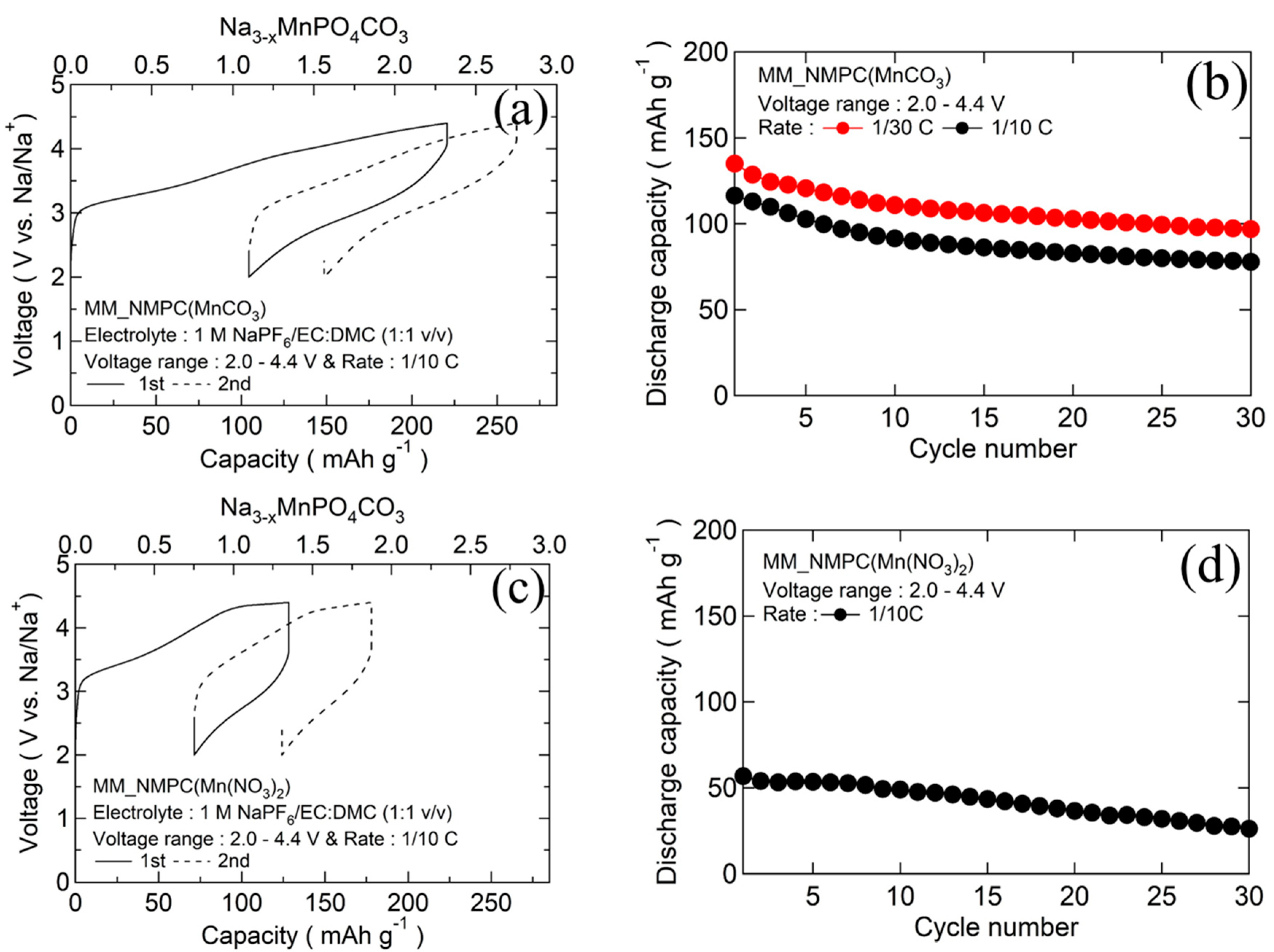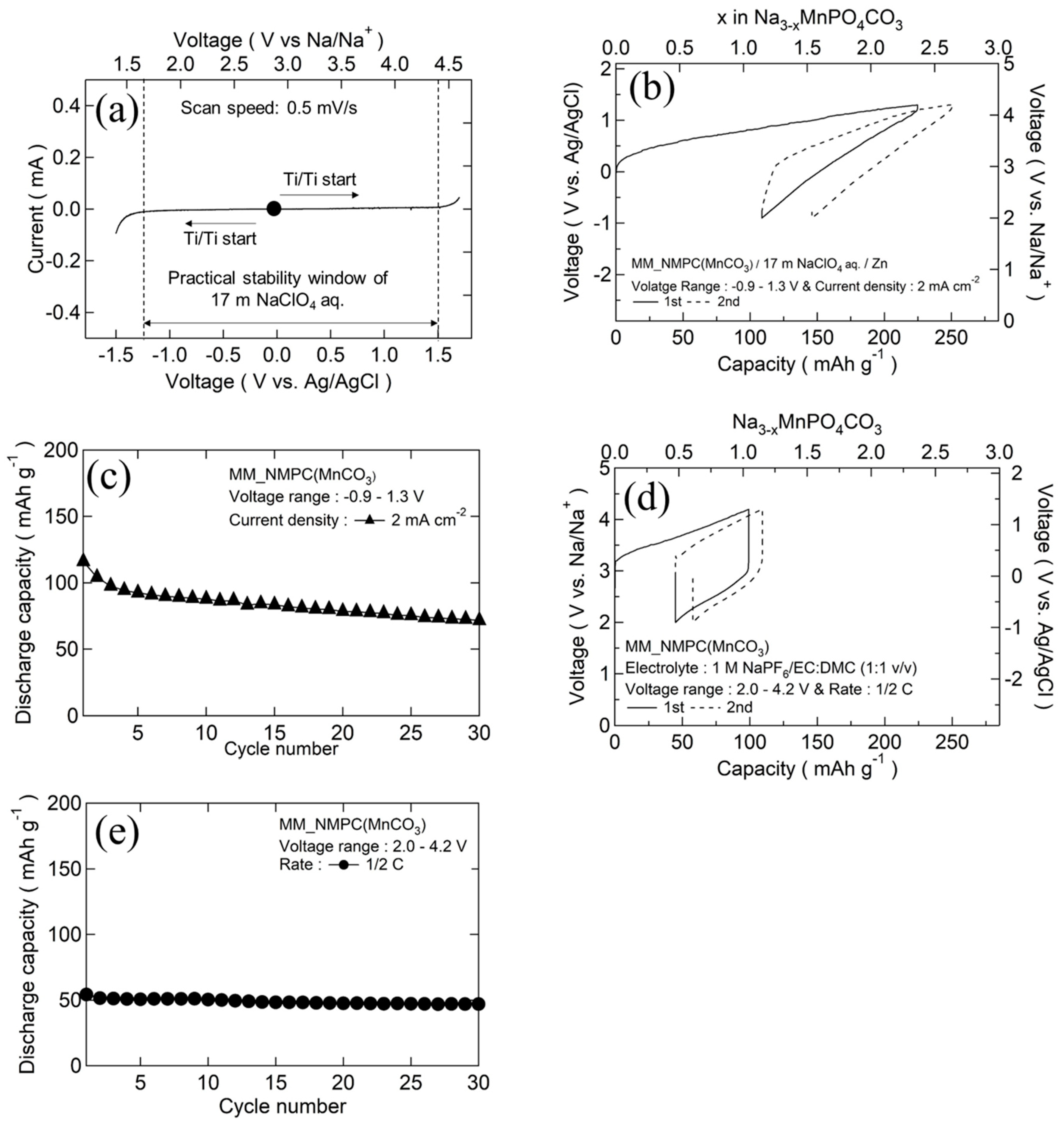Cathode Properties of Na3MnPO4CO3 Prepared by the Mechanical Ball Milling Method for Na-Ion Batteries
Abstract
:1. Introduction
2. Experimental Methods
2.1. Synthesis and Characterization
2.2. Electrochemical Measurements
3. Results and Discussion
3.1. Materials Characterization
3.2. Electrochemical Properties and Structural Change during the Charge/Discharge Process
4. Conclusions
Author Contributions
Funding
Acknowledgments
Conflicts of Interest
References
- Kim, S.W.; Seo, D.H.; Kim, H.; Park, K.Y.; Kang, K. A comparative study on Na2MnPO4F and Li2MnPO4F for rechargeable battery cathodes. Phys. Chem. Chem. Phys. 2012, 14, 3299–3303. [Google Scholar] [CrossRef] [PubMed]
- Barpanda, P.; Chotard, J.N.; Recham, N.; Delacourt, C.; Ati, M.; Dupont, L.; Armand, M.; Tarascon, J.M. Structural, transport, and electrochemical investigation of novel AMSO4F (A = Na, Li; M = Fe, Co, Ni, Mn) metal fluorosulphates prepared using low temperature synthesis routes. Inorg. Chem. 2010, 49, 7401–7413. [Google Scholar] [CrossRef] [PubMed]
- Boyadzhieva, T.; Koleva, V.; Zhecheva, E.; Nihtianova, D.; Mihaylov, L.; Stoyanova, R. Competitive lithium and sodium intercalation into sodium manganese phospho-olivine NaMnPO4 covered with carbon black. RSC Adv. 2015, 5, 87694–87705. [Google Scholar] [CrossRef]
- Barpanda, P.; Ye, T.; Avdeev, M.; Chung, S.C.; Yamada, A. A new polymorph of Na2MnP2O7 as a 3.6 V cathode material for sodium-ion batteries. J. Mater. Chem. A 2013, 1, 4194–4197. [Google Scholar]
- Ma, X.; Chen, H.; Ceder, G. Electrochemical properties of monoclinic NaMnO2. J. Electrochem. Soc. 2011, 158, A1307–A1312. [Google Scholar] [CrossRef]
- Chen, H.; Hautier, G.; Ceder, G. Synthesis, computed stability, and crystal structure of a new family of inorganic compounds: Carbonophosphates. J. Am. Chem. Soc. 2012, 134, 19619–19627. [Google Scholar] [CrossRef]
- Chen, H.; Hao, Q.; Zivkovic, O.; Hautier, G.; Du, L.S.; Tang, Y.; Hu, Y.Y.; Ma, X.; Grey, C.P.; Ceder, G. Sidorenkite (Na3MnPO4CO3): A new intercalation cathode material for Na-ion batteries. Chem. Mater. 2013, 25, 2777–2786. [Google Scholar] [CrossRef]
- Kitajou, A.; Ishado, Y.; Inoishi, A.; Okada, S. Amorphous xLiF-FeSO4 (1 ≤ x ≤ 2) composites as a cathode material for lithium ion batteries. Solid State Ion. 2018, 326, 48–51. [Google Scholar] [CrossRef]
- Wang, D.; Gao, M.; Pan, H.; Wang, J.; Liu, Y. High performance amorphous-Si@ SiOx/C composite anode materials for Li-ion batteries derived from ball-milling and in situ carbonization. J. Power Sources 2014, 256, 190–199. [Google Scholar] [CrossRef]
- Kitajou, A.; Ishado, Y.; Yamashita, T.; Momida, H.; Oguchi, T.; Okada, S. Cathode Properties of Perovskite-type NaMF3 (M = Fe, Mn, and Co) Prepared by Mechanical Ball Milling for Sodium-ion Battery. Electrochim. Acta 2017, 245, 424–429. [Google Scholar] [CrossRef]
- Hassanzadeh, N.; Sadrnezhaad, S.K.; Chen, G. Ball mill assisted synthesis of Na3MnCO3PO4 nanoparticles anchored on reduced graphene oxide for sodium ion battery cathodes. Electrochim. Acta 2016, 220, 683–689. [Google Scholar] [CrossRef]
- Bao, S.J.; Li, C.M.; Li, H.L.; Luong, J.H. Morphology and electrochemistry of LiMn2O4 optimized by using different Mn-sources. J. Power Sources 2007, 164, 885–889. [Google Scholar] [CrossRef]
- Zhou, F.; Zhu, P.; Fu, X.; Chen, R.; Sun, R.; Wong, C.P. Comparative study of LiMnPO4 cathode materials synthesized by solvothermal methods using different manganese salts. CrystEngComm 2014, 16, 766–774. [Google Scholar] [CrossRef]
- Li, W.; Dahn, J.R.; Wainwright, D.S. Rechargeable lithium batteries with aqueous electrolytes. Science 1994, 264, 1115–1118. [Google Scholar] [CrossRef] [PubMed]
- Li, W.; Dahn, J.R. Lithium-Ion Cells with Aqueous Electrolytes. J. Electrochem. Soc. 1995, 142, 1742–1746. [Google Scholar] [CrossRef]
- Suo, L.; Borodin, O.; Wang, Y.; Rong, X.; Sun, W.; Fan, X.; Xu, S.; Schroeder, M.A.; Cresce, A.V.; Wang, F. “Water-in-Salt” Electrolyte Makes Aqueous Sodium-Ion Battery Safe, Green, and Long-Lasting. Adv. Energy Mater. 2017, 7, 1701189–1701198. [Google Scholar] [CrossRef]
- Whitacre, J.; Tevar, A.; Sharma, S. Na4Mn9O18 as a positive electrode material for an aqueous electrolyte sodium-ion energy storage device. Electrochem. Commun. 2010, 12, 463–466. [Google Scholar] [CrossRef]
- Park, S.I.; Gocheva, I.; Okada, S.; Yamaki, J. Electrochemical properties of NaTi2(PO4)3 anode for rechargeable aqueous sodium-ion batteries. J. Electrochem. Soc. 2011, 158, A1067–A1070. [Google Scholar] [CrossRef]
- Pasta, M.; Wessells, C.D.; Liu, N.; Nelson, J.; McDowell, M.T.; Huggins, R.A.; Toney, M.F.; Cui, Y. Full open-framework batteries for stationary energy storage. Nat. Commun. 2014, 5, 3007–3015. [Google Scholar] [CrossRef]
- Qin, H.; Song, Z.; Zhan, H.; Zhou, Y. Aqueous rechargeable alkali-ion batteries with polyimide anode. J. Power Sources 2014, 249, 367–372. [Google Scholar] [CrossRef]
- Kumar, P.R.; Jung, Y.H.; Lim, C.H.; Kim, D.K. Na3V2O2x(PO4)2F3-2x: A stable and high-voltage cathode material for aqueous sodium-ion batteries with high energy density. J. Mater. Chem. A 2015, 3, 6271–6275. [Google Scholar] [CrossRef]
- Nakamoto, K.; Kano, Y.; Kitajou, A.; Okada, S. Electrolyte dependence of the performance of a Na2FeP2O7//NaTi2(PO4)3 rechargeable aqueous sodium-ion battery. J. Power Sources 2016, 327, 327–332. [Google Scholar] [CrossRef]
- Nakamoto, K.; Sakamoto, R.; Ito, M.; Kitajou, A.; Okada, S. Effect of concentrated electrolyte on aqueous sodium-ion battery with sodium manganese hexacyanoferrate cathode. Electrochemistry 2017, 85, 179–185. [Google Scholar] [CrossRef]
- Wang, C.; Sawicki, M.; Kaduk, J.A.; Shaw, L.L. Roles of processing, structural defects and ionic conductivity in the electrochemical performance of Na3MnCO3PO4 cathode material. J. Electrochem. Soc. 2015, 162, A1601–A1609. [Google Scholar] [CrossRef]
- Kosova, N.V.; Shindrov, A.A.; Slobodyuk, A.B.; Kellerman, D.G. Thermal and structural instability of sodium-iron carbonophosphate ball milled with carbon. Electrochim. Acta 2019, 302, 119–129. [Google Scholar] [CrossRef]
- Nakamoto, K.; Sakamoto, R.; Sawada, Y.; Ito, M.; Okada, S. Over 2 V Aqueous Sodium-Ion Battery with Prussian Blue-Type Electrodes. Small Methods 2019, 3, 1800220–1800224. [Google Scholar] [CrossRef]
- Che, H.; Chen, S.; Xie, Y.; Wang, H.; Amine, K.; Liao, X.Z.; Ma, Z.F. Electrolyte design strategies and research progress for room-temperature sodium-ion batteries. Energy Environ. Sci. 2017, 10, 1075–1101. [Google Scholar] [CrossRef]






| a (Å) | b (Å) | c (Å) | α (°) | β (°) | γ (°) | Space Group | |
|---|---|---|---|---|---|---|---|
| Na3MnPO4CO3 (ICSD no. 20-0789) | 8.99 | 6.74 | 5.16 | 90 | 90.1 | 90 | P21/m |
| MM_NMPC (MnCO3) | 8.95 | 6.80 | 5.19 | 90 | 90.1 | 90 | P21/m |
| MM_NMPC (Mn(NO3)2) | 8.91 | 6.80 | 5.18 | 90 | 89.8 | 90 | P21/m |
© 2019 by the authors. Licensee MDPI, Basel, Switzerland. This article is an open access article distributed under the terms and conditions of the Creative Commons Attribution (CC BY) license (http://creativecommons.org/licenses/by/4.0/).
Share and Cite
Xie, B.; Sakamoto, R.; Kitajou, A.; Nakamoto, K.; Zhao, L.; Okada, S.; Kobayashi, W.; Okada, M.; Takahara, T. Cathode Properties of Na3MnPO4CO3 Prepared by the Mechanical Ball Milling Method for Na-Ion Batteries. Energies 2019, 12, 4534. https://doi.org/10.3390/en12234534
Xie B, Sakamoto R, Kitajou A, Nakamoto K, Zhao L, Okada S, Kobayashi W, Okada M, Takahara T. Cathode Properties of Na3MnPO4CO3 Prepared by the Mechanical Ball Milling Method for Na-Ion Batteries. Energies. 2019; 12(23):4534. https://doi.org/10.3390/en12234534
Chicago/Turabian StyleXie, Baowei, Ryo Sakamoto, Ayuko Kitajou, Kosuke Nakamoto, Liwei Zhao, Shigeto Okada, Wataru Kobayashi, Masaki Okada, and Toshiya Takahara. 2019. "Cathode Properties of Na3MnPO4CO3 Prepared by the Mechanical Ball Milling Method for Na-Ion Batteries" Energies 12, no. 23: 4534. https://doi.org/10.3390/en12234534






